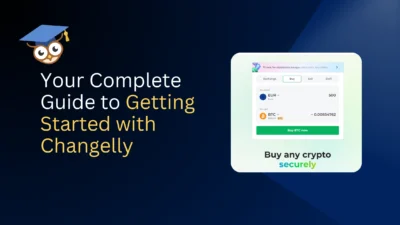There’s a dirty little secret in the world of trading: most of the work is done by robots.
As far back as 2009, more than 60% of all trades in the U.S. were done by bots. It makes sense. Bots are fast, immune to human error and emotion, and they don’t need to sleep. They’re the perfect trading assistants.
Additionally, these advantages also apply to the world of cryptocurrency trading. A good trading bot can be a massive asset here, and the best part is that it’s possible to build your own without any specialist knowledge or skills.
In this guide, we’ll show you why crypto trading bots are so great and how you can build your own.
Why Create a Crypto Trading Bot?
Bots can’t replace human traders, at least not yet. However, they do have several impressive advantages that humans can’t compete with. Here are some of the main benefits of crypto trading bots:
- They’re blisteringly fast and can execute trades in milliseconds, far quicker than any human
- Bots don’t need to sleep. That means they can monitor the markets 24 hours a day, 7 days a week… You get the picture. Bots don’t miss out on warning signs and opportunities because they were snoozing or watching the big game; they’re always 100% locked in.
- Bots aren’t vulnerable to human blunders and emotion. They don’t make impulsive decisions because they’re tired, and they don’t abandon logic because of greed or fear. Your bot will follow the predetermined rules you gave it without hesitation.
Is Programming Knowledge Essential for Creating a Trading Bot?
At this point, you might be thinking, “This all sounds great, but where do I find a trading bot? I don’t know anything about programming or coding.”
The good news is that you don’t need to. In the crazy age we’re living in, there’s no shortage of no-code platforms and applications designed to help ordinary people build highly functional bots without studying computer science for four years.
Coding does help, of course, especially if you want to build a very sophisticated or personalized bot. But it’s far from mandatory, and anyone with rudimentary tech skills and a basic knowledge of trading can get started here.
Key Components of a Crypto Trading Bot
So, what does a crypto trading bot look like? There are a few key components to be aware of here. Let’s check them out.
- Strategy logic refers to the core rules that a bot operates based on. For example, buy if RSI<30, sell if RSI>70. These rules determine when your bot should trade and under what conditions.
- Exchange API is a secure link from your bot to your exchange account, which allows your bot to access important data and submit orders on your behalf
- Market Data Handling is a live feed of information like price data and order books from the exchange. Your bot can check this feed in real-time to make trading decisions and check the conditions of your strategy.
- The Order Execution Engine is the process by which your bot responds to the data from the above sources and takes action, like buying or selling a specific cryptocurrency
- Risk Controls are built-in safety rules, such as stop-loss orders, take-profit targets, position size limits, and cooldown timers. For example, many platforms allow you to prohibit your bot from risking more than 2% of your funds on any given trade.
- Backtesting/Simulation is a process where bots can test your strategy against historical trade data to show you past hypothetical performance. This can provide you with important insights and help you refine your strategy.
- User Interface & Monitoring is a dashboard that provides access to key information, including current positions, P&L, and performance metrics. Your bot might even be able to send you real-time updates and notifications via messaging apps.
How to Build a Crypto Trading Bot Without Programming Knowledge
Now that we’ve looked at the benefits of crypto trading bots and their key components, let’s dive into the actual process of building one. In this section, we’ll show you the main steps involved.
Step 1 – Choose a No-Code Trading Bot Platform
There are several excellent bot-building platforms out there, which we’ll explore later in the article. Your first step should be to choose the platform that’s right for you.
You should consider whether the platform connects to your preferred exchanges (most bot platforms cover big exchanges like Binance and Kraken, but it’s worth checking).
Another big factor is your experience level. Some platforms are entirely no-code and aimed at beginners, while others are more technical and assume some level of coding skill.
Don’t forget security, either. Bots that prioritize safety will encrypt API keys, let you whitelist IPs, and disable withdrawal permissions to give you peace of mind.
Of course, you should always check the cost. Bot platforms range from completely free, like Pionex, to varying monthly fees. Find out what works within your budget and needs.
Finally, it’s worth considering the community and support around each platform. Some platforms offer tons of resources, guides, and support features, and have big and engaged communities of users. This can make the learning process much easier and help you get more out of the platform.
Step 2 – Create an Account and Set Up Your Dashboard
Once you’ve settled on a platform, it’s time to set up your account.
The process here is going to look slightly different for every platform, but there are some common elements that you’ll find in most of them:
- A Strategy Builder or Editor section, where you’ll set your trading rules and tell the platform what you want your bot to do
- A Markets or Exchange Connection area where you’ll link API keys
- A Portfolio/Terminal tab where you can look at information about your holdings, open trades, and other metrics
- A Templates or Copy Trading feature, where you can clone existing strategies
Step 3 – Connect Your Crypto Exchange via API
Once you’ve set up your account, it’s time to connect it to your crypto exchange so it can access all the relevant data and start making trades.
Again, this process is unique for every platform, but here’s a rough idea of what to expect:
- First, log in to your exchange account
- Find the API key management page. This is usually under account settings.
- Create a new API key. Give it a name (e.g., “MyBotKey”) and enable only trading permissions. Crucially, disable withdrawal rights: your bot should never need to move funds out of the account.
- Complete any verification. Often, exchanges will send a code to your email or require two-factor authentication before finalizing the key.
- Copy the API Key and Secret. Treat these like passwords! Don’t share them.
- In your bot platform, paste the API Key and Secret into the exchange connection settings. The bot should then verify that it can see your balances.
Step 4 – Define Your Trading Strategy With Risk Management
Now for the juicy part: setting up the rules that your bot will follow. This is what makes your bot unique and determines its effectiveness, so it’s worth taking some time to get it right.
Here are the most important rules to focus on:
- Entry and exit rules determine the conditions for buying and selling. An example here might be asking your bot to buy ETH when the 50-day moving average crosses above the 200-day moving average, and to sell when the reverse happens. Many platforms offer dropdown menus or templates to help you set up these rules.
- Trade pair and order size allow you to determine which cryptocurrencies to trade and how much to trade according to each signal
- Risk controls enable you to establish protective rules, such as instructing your bot to exit if the price falls 3% below the entry price. Stop losses and position size limits are also extremely useful and can prevent massive losses.
Some platforms also include more advanced options, like the ability to set cooldown periods between trades or use conditional logic blocks to create rules.
Step 5 – Backtest Your Strategy
Backtesting your strategy on historical data can be a useful way to gauge its effectiveness in the real world.
Of course, as the old adage goes, past performance is no indicator of future success. But backtesting can still be useful.
To get started, find the backtesting section in your bot platform, select the strategy you created in the previous step, and choose a historical date range to test it on. Consider metrics such as total return, win-loss rate, and drawdown. Your platform may also generate an equity curve and provide you with feedback on your results.
For optimal results, test your strategy across multiple time frames and market conditions. The more data, the better. Once you have a solid amount of feedback, review the results and make changes accordingly. It’s best to make any tweaks one at a time and keep them small, then test again. Gradually, over time, you’ll improve your strategy,
Step 6 – Test it in Paper Trading Before Going Live
Paper trading is where you run your bot using virtual funds in real market conditions. It’s essentially a dress rehearsal for real trading, helping you battle-test your strategy while keeping the stakes low.
Navigate to the section of your platform labeled ‘paper trading’ or ‘demo trading,’ and follow the instructions. It’s best to run your bot over a few days or weeks and check periodically to ensure it’s following your rules exactly as intended.
Monitor your bot’s progress and keep an eye out for any unexpected losses, unwanted activity (such as excessive trades), or bugs (like API disconnects or logic errors). If something appears incorrect, pause and make any necessary adjustments.
Step 7 – Monitor and Optimize
A crypto trading bot is not something you should “set and forget”.
Once your bot is live, it’s essential to monitor it closely, especially in the early days, to ensure that everything is going according to plan.
In your platform’s dashboard, pay attention to metrics like P&L, open positions, and open trades. It’s a good idea to enable alerts via email or messaging apps in case of any critical events like order failures or large drawdowns.
Compare your results with the assumptions you made based on your backtests. Markets are inherently unpredictable, and cryptocurrency markets are particularly volatile.
Strategies that work amazingly well in theory can crash and burn spectacularly in the real world, so stay vigilant and make adjustments as often as necessary to keep things on the right track.
It’s Important to Understand the Risks and Challenges of Trading Bots
Bots are not perfect. There are many unique challenges and risks to consider here, and if you fail to prepare for these, it could cost you.
Here are some major risks and challenges to be aware of:
Market volatility
Crypto is a famously volatile market and can swing wildly. Bots can’t predict the future, and even the best-tested strategy in the world can encounter a major dip. To protect yourself here, always use stop-loss orders, cap your position sizes, and instruct your bots to never trade money you can’t afford to lose.
Overfitting
Overfitting is where your strategy is too closely matched to specific past data, to the point where it fails when it actually goes live. To avoid this risk, test your bots on a wide range of data, use simpler strategies, and be wary of adding too many custom parameters.
Technical Errors
Problems like software bugs, internet outages, and exchange downtime can all break your bot. To mitigate the risk, start trading with small amounts, opt for a reliable platform with solid support, and keep backup access to your funds.
Execution Risk
In the real world, trades can incur slippage and fees, which can eat into your returns, and backtests can often overlook these costs. Make sure your bot accounts for such fees and unexpected setbacks.
A False Sense of Security
Automated trading can sometimes lull users into complacency, especially when you consider that a lot of bots are sold using hype and guarantees. When choosing and setting up your bot, always be skeptical. Read user reviews and regulatory warnings carefully, and never trust your entire portfolio to bots.
Top No-Code Crypto Trading Bot Building Platforms
There are several excellent options out there when it comes to building your own crypto trading bot. In this section, we’ll dive into 5 of the best platforms, who they’re for, and what makes them great.
Pionex (Free)
Starting with the cheapest option, Pionex is an exchange with its own built-in trading bots, which means it basically functions as a crypto exchange that runs your bot logic for no extra fee (only trading fees apply). It’s simple and beginner-friendly, but it does have fewer customization options than other platforms, and you’re restricted to Pionex’s exchange, which has limited coins compared to bigger exchanges.
3Commas
3Commas supports major exchanges like Binance and Coinbase, and offers multiple bot types. It’s user-friendly and offers strong features, including multi-exchange support, a smart trading terminal, and advanced trailing features. Pricing ranges from free to $59 per month.
Cryptohopper
Cryptohopper is built especially for non-coders and allows you to build your own trading bot without writing a single line of code. Its drag-and-drop strategy designer makes it incredibly simple to create your bot, and there’s a mobile app and advanced backtesting features. Pricing ranges from free to $107.50 per month.
Bitsgap
With Bitsgap, you can create arbitrage bots that simultaneously trade price differences across exchanges, as well as more conventional bot types like Grid and DCA. It works with most major exchanges and comes with a clean and user-friendly interface. Prices range from $23 per month to $120 per month.
Altrady
Altrady is a multi-exchange trading terminal with built-in bots. It prioritizes speed and execution across different exchanges, but it does come with the learning curve of a full trading terminal, so it may not be suitable for complete beginners. Pricing ranges from $22 per month to $70 per month.
Is Building a Trading Bot Worth It?
So, is building a crypto trading bot worth it?
The only one who can really answer this question is you. Bots can save you time, eliminate human error, and help you rigorously test your strategies before they go live. On the other hand, a badly designed bot can lose you a lot of money fast, and there’s always a risk of glitches, bugs, and outages.
Bots need to be monitored and tweaked constantly. They are not magic, and they’re certainly not a low-effort strategy, but they can be a fantastic tool when it comes to disciplined, rules-based trading and idea testing.
Learn How Dypto Crypto Can Be Your Learning Partner in the Crypto Space
Bots are just one of many crypto-related topics you can learn about on the Dypto-Crypto website.
We built our site to help people learn more about the world of DeFi and crypto trading, so you can make more informed and safe decisions in this often confusing space.
Check out our cryptionary, how-to-guides, and e-book to learn more, and sign up for our newsletter for regular updates on all the latest news, opportunities, and trends.
Frequently Asked Questions (FAQs)
Q: Can I build a crypto trading bot without knowing how to code?
Yes, there are platforms out there designed to help you build your own trading bot without any coding knowledge at all.
Q: What is the best platform to create a crypto trading bot without coding?
There are many good options depending on your experience level and personal preferences. Pionex, 3Commas, and Cryptohopper are 3 well-known examples.
Q: Is it safe to use a crypto trading bot?
Usually, but always be sure to do your homework. Research regulatory compliance measures, read reviews, and never trust any bot with all your funds.
Q: How much does it cost to build a crypto trading bot?
Crypto bot building platforms come at a range of price points. Some have free options, while others are only available to paid users. Usually, more sophisticated options will cost more.
Q: Can a trading bot guarantee profits?
No, no bot can guarantee profits since market conditions are impossible to predict with 100% accuracy.







